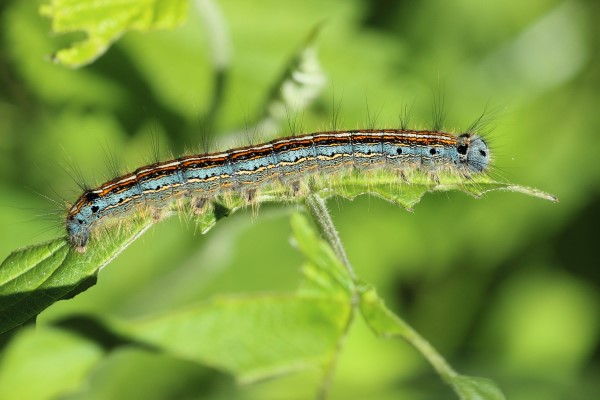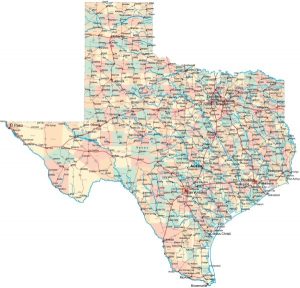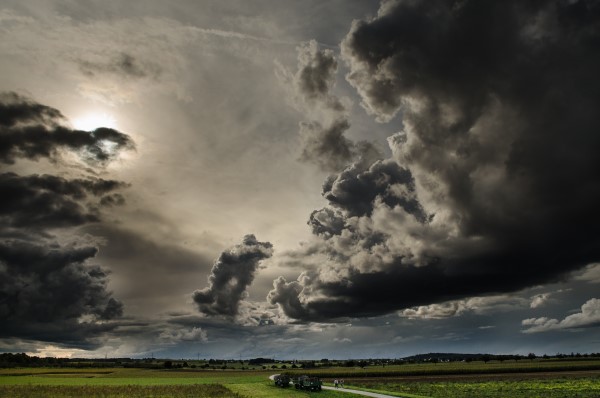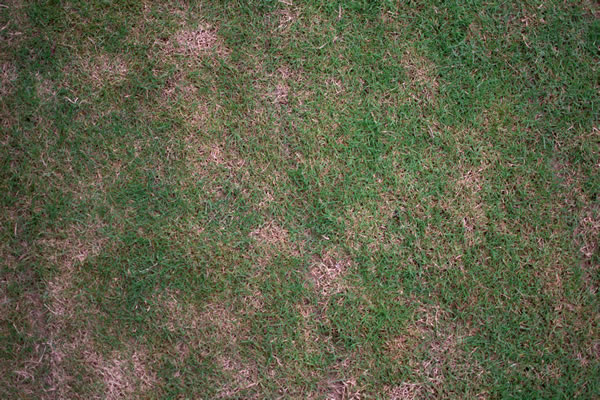If you live in north Texas you have probably heard about the armyworm invasion that has blighted lawns all across the region. Troops of these unwanted pests have marched through yards of all shapes and sizes and brought with them a wave of swift destruction. Though you have probably encountered the armyworm before, this September brought with it a conspicuous clash between battalions of the caterpillars and the homeowners and landowners desperate to save their property from pillage. But what exactly are armyworms and what do you need to know about them before preparing for battle?
What are armyworms?
Armyworms are a type of moth with several species common to Texas, but when we speak of armyworms in general we are referring to fall armyworms whose larval stage is known for causing destruction to plants en masse. The larvae, caterpillars, can grow to about 1″ to 1.5″ long and are either green, brown or black with a few distinguishing markings. Those markings are: a dark head featuring a light inverted “Y”, longitudinal black stripes on each side of its body, a yellow-gray stripe along the middle of its back, and four black dots near the rear end. It’s in this caterpillar form that the fall armyworms are most easily identifiable and the most damaging.
Where do armyworms come from?
Armyworms are preferential pests of warmer climates, and will actually overwinter in southern Texas due to their sensitivity to cold and inability to endure it in any stage of their life-cycle. When weather conditions are favorable, and spring is heading into summer, the prolific armyworm moths will migrate north and lay their eggs at the base of suitable host plants (and sometimes even nearby structures like fences and light posts). One female moth can deposit up to 2000 eggs in clusters of 50 or more, but there’s not much point in searching for these eggs as they are incredibly small and very difficult to detect. In approximately a week these stealthy eggs will hatch into the larval stage, the caterpillars discussed above, which will lay siege to grasses and crops, growing ever larger as they feed over the next several weeks. They will attack an area en masse before moving together to a new feeding ground, in the process making it clear why these pests would have been named an “army”worm as their legions continue with their assault. Once they have eaten their fill, they will then pupate in the soil, emerging as adult moths approximately ten days later. And the cycle continues, with anywhere from three to six generations commonly produced each season. As summer draws to a close, they will head back to south Texas and wait for temperatures to rise again.
When is armyworm season?
As mentioned above, armyworms prefer warm weather, but even more so than that, they thrive on above-average rains in late summer and early fall, which ensure a high egg survival rate. The record amounts of rain received this September are the reason these pests have come out in droves and become a newsworthy topic as generation after generation march forth. The fall onslaught is actually a pretty common occurrence, though rarely to the magnitude we are seeing this year, as several generations of the pests emerge quickly, unlike the more sporadic solitary outbreaks that happen in spring and summer. Stormy weather also benefits the fall armyworm moth, which is a strong flier, as the turbulent weather can help them evade their natural predators. So though there isn’t a predictable armyworm season, any time we have late summer and early fall storms there’s a good chance you’ll find an armyworm attack in the near future.
What do armyworms eat?
Armyworms are not very picky eaters and will attack an array of plants. Some of the most common food sources are warm-season turfgrasses, grains, corn, sweet potato, beans, turnips, clover, tobacco, spinach, cucumber, potatoes, tomatoes, cabbage, and the list goes on. Their preferred mealtimes are early in the morning and late in the evening, but again they are not discriminate eaters and will feed any time of the day or night.
What kind of damage do armyworms do?
Though they aren’t overly preferential with their food sources, they do regularly feast upon turfgrass (like bermudagrass and bluegrass). In fact, they are a major cause of damage to turfgrass in residential lawns, athletic fields and golf courses. The destruction they inflict is that of foliage consumption. The caterpillars will chew the green layer of blades of grass or leaves, starting at the tips, creating a transparent section in its wake, almost like a window pane. If you’re looking at the yard as a whole, instead of at a single blade, you would notice that the grass appears off-color or brown. As the infestation progresses, the damage done will rapidly advance from small transparent sections to destruction of the entire blade or leaf. Once they have stripped the plants in an area, they will charge the next available food source. Since armyworms often produce very large larval populations, they are capable of causing significant widespread damage in a very short amount of time.
Will armyworms kill my lawn?
Generally speaking, even with the significant defoliation that armyworms will inflict, many turfgrasses, such as bermudagrass, are resilient enough to recover from the onslaught provided that they were healthy to begin with. You will, however, be faced with the aesthetic devastation of your lawn until the grass recovers. And there is no way to know for sure if your grass will recover; newly established grasses like ryegrass or fescue can most certainly be stunted or killed by armyworms.
How do you control armyworms?
The most important step in controlling armyworms is to keep a vigilant eye on the foliage in your yard, especially your lawn. Watch for discoloration of the grass and look for the caterpillars themselves, which will be easiest to find when they are most active in the early morning and late evening. Pay special attention to any area of lush plant growth as it’s a preferred place for the moths to lay their eggs. And remember that maintaining a healthy and manicured lawn will be especially helpful in the prevention of an armyworm invasion. If you see a lot of the caterpillars or evidence of their attack, immediately call in a pest control professional to treat as quickly as possible to reduce the level of damage inflicted.
Armyworms are not a pest to be trifled with, as their name would suggest. These pests are experts at attacking foliage and stripping blades of grass or leaves bare in record time. They seem to show up overnight in multitudes and can change the entire aesthetic of your yard before you even realize you’re facing a mighty foe. So when fall draws near and storms begin to pop up, keep your pest control company’s number close at hand to get help as soon as the invasion begins.
Additional References:
Armyworms in Turfgrass – Insects in the City – Texas A&M AgriLife Extension
The Fall Armyworm – A Pest of Pasture and Hay. – Allen Knutson, Extension Entomologist, Texas A&M AgriLife Extension Texas A&M AgriLife Research and Extension Center, Dallas
Armyworm – Casey Reynolds, PhD, Mike Merchant, PhD and Diane Silcox Reynolds, PhD – AggieTurf










